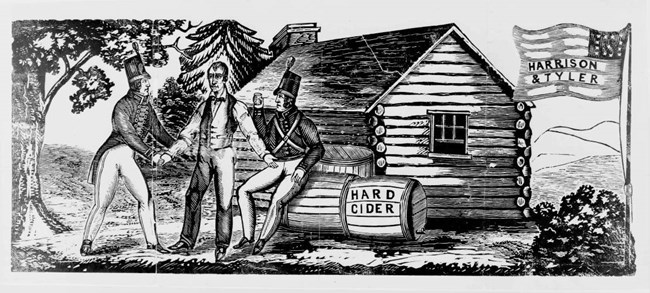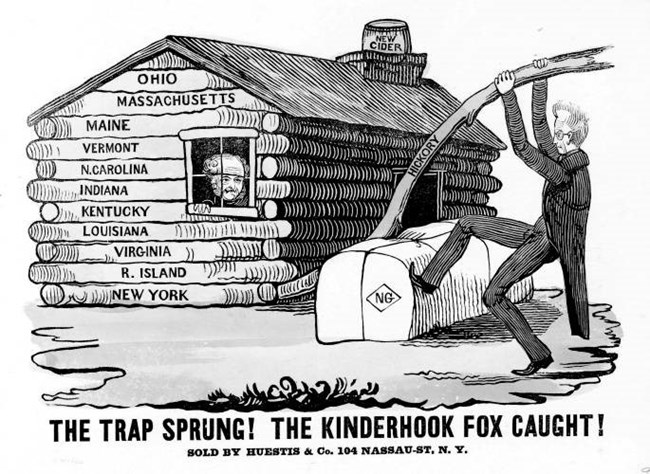
Library of Congress Just as their beginnings differed, so too did their career paths. Van Buren, never served in the military and instead focused his endeavors on law and becoming a seemingly well-paid government official. Harrison meanwhile, following the death of his father in 1791, Harrison enlisted in the military where during the War of 1812 he was appointed Major General after having spent the past 12 years as the first Governor of Indiana. Harrison used this military experience to his advantage. He ran as a war-hero and “man-of-the-people”, a similar strategy that Andrew Jackson had used in his campaigns. This rough and tough imaged proved wildly popular. The campaign he and Tyler ran under adopted the slogan “Tippecanoe and Tyler too”. “Tippecanoe” referred to the river of the same name near Harrison’s military victory over a group of Shawnee Native Americans. The Whigs, led by congressman such as Henry Clay, led ruthless attacks against Van Buren scrutinizing every move he made. Charles Ogle, a representative from Pennsylvania, spent three days accusing Van Buren of living in luxury at considerable public expense during hard economic times. "If he is vain enough to spend his money in the purchase of rubies for his neck, diamond rings for his fingers, Brussels lace for his breast, filet gloves for his hands, and fabrique de broderies de bougram à Nancy handkerchiefs for his pocket—if he chooses to lay out hundreds of dollars in supplying his toilet with 'Double Extract of Queen Victoria', Eau de Cologne, Corinthian Oil of Cream ... if, I say, Mr. Van Buren sees fit to spend his cash in buying these and other perfumes and cosmetics for his toilet, it can constitute no valid reason for charging the farmers, laborers and mechanics of this country with bills for HEMMING HIS DISH RAGS, FOR HIS LARDING NEEDLES, LIQUOR STANDS, AND FOREIGN CUT WINE COOLERS." – Charles Ogle 
Library of Congress While the attacks on Van Buren focused on his “lavish” lifestyle and the state of the economy, the Democrats in turn labeled Harrison as an abolitionist and of being in poor health. The Democrats accused Harrison of being an abolitionist in part due to his prior membership with the Richmond Humane Society, an anti-slavery group, and his mixed-record on slavery while a member of Congress. The attacks on his health tried to paint the former General as decrepit due to him being aged 67. Their tactics proved ineffective as Harrison rallies grew to unprecedented size with Harrison himself even making appearances at some of them. This broke the custom that presidential hopefuls should not campaign for office, but rather let the office seek the man. There was not a national election day in 1840 with votes being counted from October 30-December 2, 1840. The heavy campaigning by the Whigs proved successful as Harrison carried 19 of the 26 states. Van Buren didn’t even win in New York, his home state. Harrison defeated Van Buren by over 100,000 votes and soundly took the electoral vote as well 234-60. With his defeat, Van Buren became a one-term President and relocated to his newly purchased estate, Lindenwald, in Kinderhook, New York. Harrison on the other hand, his victory made him the oldest elected U.S. President until Ronald Reagan in 1980! |
Last updated: December 16, 2020
